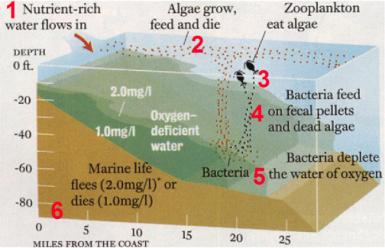NOAA, partners predict an average 'dead zone' for Gulf of Mexico

This image shows nutrient-based hypoxia formation. Credit: Nancy Rabalais, LUMCON
Scientists are expecting that this year's Gulf of Mexico hypoxic zone, also called the “dead zone,” will be approximately 5,483 square miles or about the size of Connecticut-the same as it has averaged over the last several years.
The dead zone in the Gulf of Mexico affects nationally important commercial and recreational fisheries and threatens the region's economy. Hypoxic zones hold very little oxygen, and are caused by excessive nutrient pollution, primarily from activities such as agriculture and wastewater. The low oxygen levels cannot support most marine life and habitats in near-bottom waters.
This year marks the first time the results of four models were combined. The four model predictions ranged from 4,344 to 5,985 square miles, and had a collective predictive interval of 3,205 to 7,645 square miles, which take into account variations in weather and oceanographic conditions.
The NOAA-sponsored Gulf of Mexico hypoxia forecast has improved steadily in recent years, a result of advancements of individual models and an increase in the number of models used for the forecast. Forecasts based on multiple models are called ensemble forecasts and are commonly used in hurricane and other weather forecasts.
The ensemble models were developed by NOAA-sponsored modeling teams and researchers at the University of Michigan, Louisiana State University, Louisiana Universities Marine Consortium, Virginia Institute of Marine Sciences/College of William and Mary, Texas A&M University, North Carolina State University, and the United States Geological Survey (USGS). The hypoxia forecast is part of a larger NOAA effort to deliver ecological forecasts that support human health and well-being, coastal economies, and coastal and marine stewardship.
“NOAA, along with our partners, continues to improve our capability to generate environmental data that can help mitigate and manage this threat to Gulf fisheries and economies,” said Kathryn D. Sullivan, Ph.D., under secretary of commerce for oceans and atmosphere and NOAA administrator. “We are adding models to increase the accuracy of our dead zone forecast.”
The Gulf of Mexico hypoxia forecast is based on nutrient runoff and river stream data from the USGS. The USGS operates more than 3,000 real-time stream gauges, 50 real-time nitrate sensors, and collects water quality data at long-term stations throughout the Mississippi River basin to track how nutrient loads are changing over time.
The USGS estimates that 104,000 metric tons of nitrate and 19,300 metric tons of phosphorus flowed down the Mississippi and Atchafalaya rivers into the Gulf of Mexico in May 2015. This is about 21 percent below the long-term (1980-2014) average for nitrogen, and 16 percent above the long-term average for phosphorus.
“Real-time nitrate sensors are advancing our understanding of how nitrate is transported in small streams and large rivers, including the main stem of the Mississippi River,” said William Werkheiser, USGS associate director for water. “Long-term monitoring is critical to tracking how nutrient levels are changing in response to management actions and for improving modeling tools to estimate which sources and areas are contributing the largest amounts of nutrients to the Gulf. “
The confirmed size of the 2015 Gulf hypoxic zone will be released in early August, following a monitoring survey led by the Louisiana Universities Marine Consortium from July 28 to August 4.
###
USGS provides science for a changing world. Visit USGS.gov, and follow us on Twitter @USGS and our other social media channels. Subscribe to our news releases via email, RSS or Twitter.
NOAA's mission is to understand and predict changes in the Earth's environment, from the depths of the ocean to the surface of the sun, and to conserve and manage our coastal and marine resources. Join us on Facebook, Twitter, Instagram and our other social media channels.
Media Contact
All latest news from the category: Earth Sciences
Earth Sciences (also referred to as Geosciences), which deals with basic issues surrounding our planet, plays a vital role in the area of energy and raw materials supply.
Earth Sciences comprises subjects such as geology, geography, geological informatics, paleontology, mineralogy, petrography, crystallography, geophysics, geodesy, glaciology, cartography, photogrammetry, meteorology and seismology, early-warning systems, earthquake research and polar research.
Newest articles

First-of-its-kind study uses remote sensing to monitor plastic debris in rivers and lakes
Remote sensing creates a cost-effective solution to monitoring plastic pollution. A first-of-its-kind study from researchers at the University of Minnesota Twin Cities shows how remote sensing can help monitor and…

Laser-based artificial neuron mimics nerve cell functions at lightning speed
With a processing speed a billion times faster than nature, chip-based laser neuron could help advance AI tasks such as pattern recognition and sequence prediction. Researchers have developed a laser-based…

Optimising the processing of plastic waste
Just one look in the yellow bin reveals a colourful jumble of different types of plastic. However, the purer and more uniform plastic waste is, the easier it is to…



